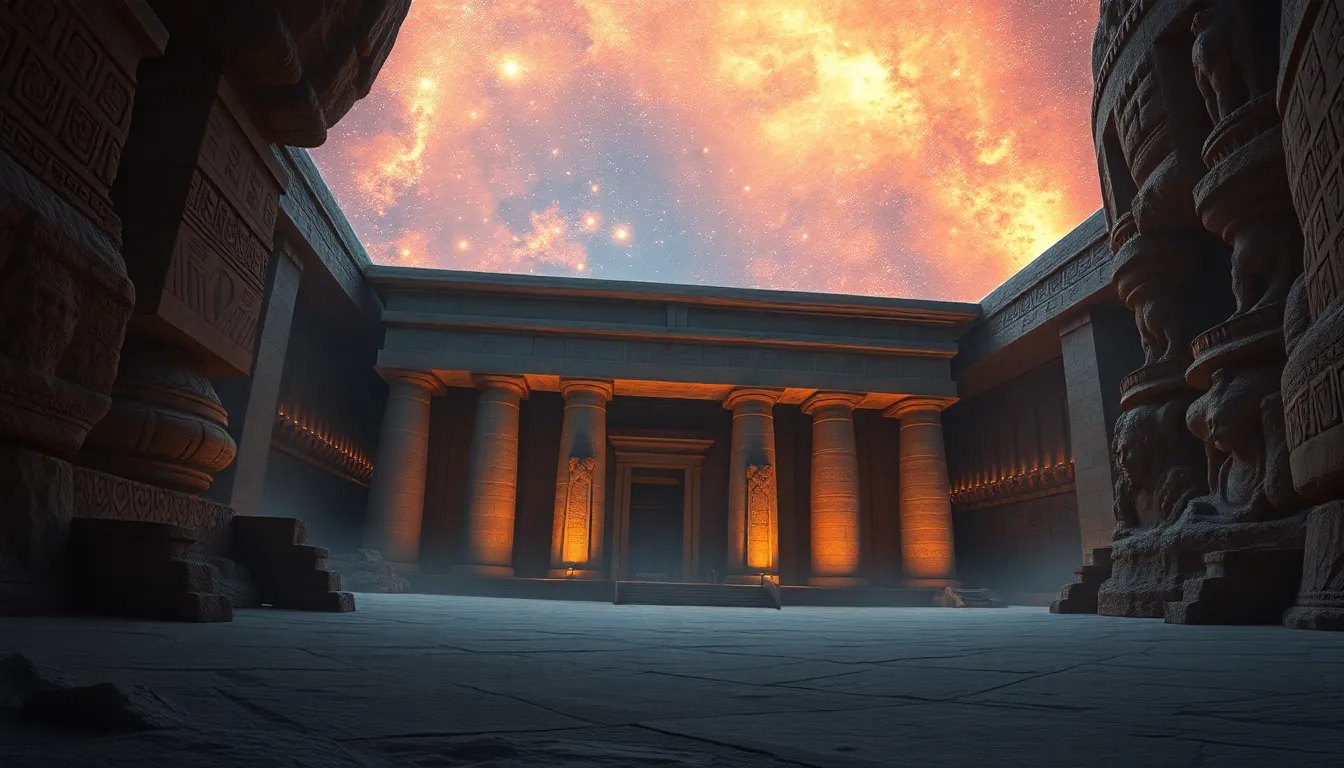The Temple of Nut: The Cosmic Embrace
I. Introduction
The Temple of Nut, dedicated to the ancient Egyptian sky goddess, is a remarkable structure that exemplifies the rich tapestry of Egyptian mythology and architecture. It serves as a monument to the significance of Nut in the pantheon of Egyptian deities and reflects the deep connection the ancient Egyptians had with the cosmos.
In ancient Egyptian culture, the Temple of Nut was not merely a place of worship; it was a celestial observatory that aligned with the stars and the rhythms of nature. This article aims to explore the historical context, symbolism, architectural design, rituals, and modern significance of the Temple of Nut, revealing its importance in understanding ancient Egyptian spirituality.
II. Historical Context
The origins of the Temple of Nut can be traced back to the early dynastic period of ancient Egypt, around 3000 BCE. As the mythology surrounding Nut developed, she became a central figure in the creation stories, often depicted as the arching sky that enveloped the earth.
In Egyptian mythology, Nut is the daughter of the sky god, Shu, and the earth goddess, Tefnut. She is often portrayed as a woman arched over the earth, her body covered with stars, symbolizing the night sky. The temple dedicated to her was built to honor her role as the mother of the stars and the protector of the heavens.
The architectural features of the Temple of Nut reflect the grandeur and artistry of ancient Egyptian construction. Built with sandstone and adorned with intricate carvings, it served as a functional space for both rituals and astronomical observations throughout its historical timeline.
III. Symbolism of Nut
Nut’s symbolism is profound, representing various aspects of existence and the cosmos:
- Representation of the night sky: Nut embodies the night sky, often depicted with her body dotted with stars, symbolizing the celestial realm.
- Nut as the mother of the stars: She is considered the mother of the sun god Ra, who is reborn each morning, and the stars which traverse her body at night.
- Connection between Nut and fertility: Nut’s association with the sky signifies the nurturing aspect of the heavens, believed to provide life-giving rain to the earth.
IV. Architectural Design and Layout
The Temple of Nut boasts several key structural elements that highlight its significance:
- Pillared halls: The temple features grand pillared halls that served as gathering spaces for worshippers and priests.
- Sanctuaries: Dedicated areas where rituals were performed, often housing statues of Nut and other deities.
- Celestial alignments: The temple was meticulously designed to align with specific celestial events, enhancing its role as an astronomical observatory.
Symbolic motifs and decorations throughout the temple include images of stars, celestial bodies, and hieroglyphics that narrate the myths associated with Nut and her cosmic significance. These elements were not only decorative but served as a means of conveying religious beliefs and practices to the worshippers.
V. Rituals and Practices
Rituals at the Temple of Nut played a crucial role in the spiritual life of ancient Egyptians:
- Ceremonies: The temple hosted various ceremonies, particularly during significant astronomical events, such as solstices and equinoxes, when the alignment of the temple with the stars became particularly meaningful.
- Agricultural cycles: The temple was integral to the agricultural calendar, as the cycles of planting and harvesting were closely linked to the celestial movements and the flooding of the Nile.
- Role of priests and priestesses: Priests and priestesses performed daily rituals, offerings, and maintained the temple, ensuring that the connection between the divine and the earthly realm was preserved.
VI. Cosmic Embrace: Interpretation and Meaning
The concept of the cosmic embrace is central to understanding Nut’s role in Egyptian beliefs. She represents the union of the sky and earth, enveloping her counterpart, Geb, the earth god, in an eternal embrace. This relationship symbolizes the balance of nature and the interconnectedness of all things.
Nut’s cosmic embrace has several implications:
- It highlights the ancient Egyptians’ view of the universe as a cohesive and harmonious whole.
- Her relationship with Geb illustrates the dualities in nature—light and dark, male and female, life and death—reflecting a broader understanding of existence.
- Nut’s role in the cycle of life and death reinforces the belief in resurrection and the afterlife, central themes in Egyptian spirituality.
VII. Preservation and Modern Significance
In recent years, archaeological efforts have focused on the preservation and study of the Temple of Nut. Discoveries made at the site have shed light on the architectural techniques and religious practices of ancient Egyptians.
Today, the Temple of Nut holds significance in contemporary culture:
- It serves as a site for research and education, attracting scholars and tourists interested in ancient Egyptian history and mythology.
- The temple inspires modern interpretations of spirituality and mythology, influencing contemporary art, literature, and spiritual practices.
- Preserving ancient heritage is vital for understanding our shared human history and the evolution of religious beliefs.
VIII. Conclusion
In conclusion, the Temple of Nut stands as a testament to the profound significance of Nut in ancient Egyptian culture. Its architectural grandeur, rich symbolism, and the rituals that took place within its walls reflect the deep spiritual connection the ancient Egyptians had with the cosmos.
As we reflect on the enduring legacy of Nut, we recognize the universal themes of creation, fertility, and the balance of nature that resonate through her mythos. The cosmic themes embodied in the Temple of Nut continue to inspire and inform our understanding of spirituality and the universe, reminding us of the ancient wisdom that still holds relevance today.




